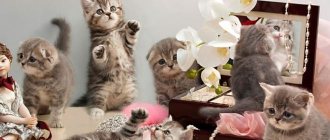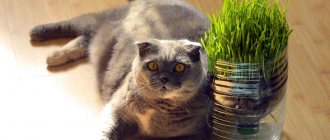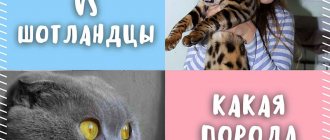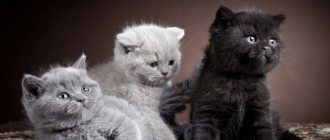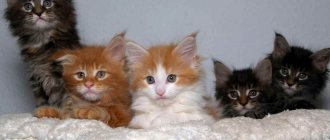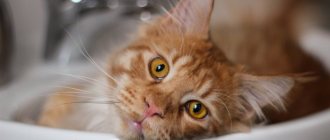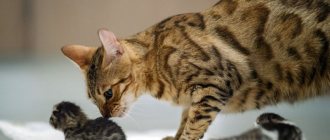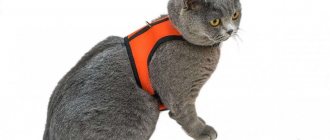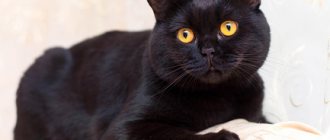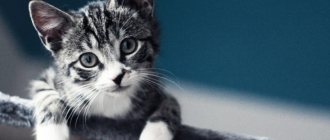We choose a kitten not only with our minds, but also with our hearts. After all, we will have to walk side by side with our pet for the next 15-20 years. He will become a member of the family. He will live with us in perfect harmony... Or vice versa? This depends, among other things, on how correctly we select our future friend, singling him out from among all the others. So, how to choose the right Scottish fold and straight-eared kitten - healthy, purebred, beautiful, with a good character? And what are the features of Scottish fold and straight-eared kittens that distinguish them from all the others?
MAIN THOUGHTS OF THE ARTICLE
► unscrupulous sellers, under the guise of Scottish ones, sell mongrels or mestizos;► choosing a Scottish kitten with good breed characteristics is difficult without experience, but we will try to teach;
► good kittens cannot be cheap; they are sold in certified nurseries by certified felinologists;
► the price depends on the class of the kitten.
Choosing a kitten class
Breeders know that the division into classes is very arbitrary: it only helps determine the baby’s career prospects . Often kittens of the same litter fall into different classes, but this is always the personal point of view of the breeder. In addition, in the process of growth there are transitions from breed to pet, from show to breed and vice versa.
Show class (show – display, demonstration)
This includes kittens that fully comply with the breed standard, without disqualifying characteristics or shortcomings. Reference cats are included in the top show class (top – top, highest). These animals remain in nurseries for breeding and exhibition activities. Show-class kittens (the pride, decoration and advertising of the nursery) are practically not put up for sale. Such copies are sold for a lot of money and with reservations - “on conditions” or “in co-ownership”.
Breed class (breed – tribe)
This group is represented only by cats with excellent pedigrees and excellent reproductive capabilities. They also appear at shows and win titles that give them the right to participate in breeding. With proper selection, show-class offspring are obtained from such females.
This is interesting! Breeding males usually fall into the pet category, since a breeding cat is judged not so much by its pedigree and conformation, but by the health and quality of the kittens it produces.
Such animals are often sold with the condition of mandatory removal of the reproductive organs, which does not prevent them from having a pedigree and claiming exhibition regalia (in the “castrati” category). The price for breed-class cats is in the average price range. It happens that show-class kittens are found among breed-quality animals. This happens due to oversight or due to insufficient experience of the breeder.
Pet class (pet – pet)
These are purebred kittens that, in the opinion of the breeder, are not of interest either for exhibitions or for breeding. They often have disqualifying defects that do not threaten health or life.
Such kittens are sold already neutered or with the condition of spaying. A pedigree for a pet-class animal is issued only at the request of the buyer: in this case, the entry “not for breeding” appears in the documents. The cost of pet quality kittens is the lowest.
Return to content
How quickly does a cat forget her kittens?
By 12 weeks, a good mother cat gives the kitten everything it needs (milk, useful skills), and from this age the kitten can live independently in a new family. If there is no need for separation, the cat continues to live with the children until they are six months old.
Interesting materials:
What budget can be considered the best 3rd grade? What kind of brushing for short hair? What does Brie taste like? What was Stolz like? What was Lisa like in the story Poor Lisa? What day is celebrated on December 9? What is the diameter of the central circle? What diesel engine is installed on the UAZ Hunter? How long should skis be for skating? How long should skis be?
Choosing the gender of the kitten
When thinking about who is more useful on the farm, a cat or a male cat, you should not blindly trust the description of the breed’s character, as well as theses about the greater affection of females and the unsociability of males. In practice, everything may turn out differently, since the disposition of the future pet depends little on its gender, and sometimes even contradicts the breed characteristics.
That is why, when deciding on the gender of the Scottish Fold, proceed from a specific goal . If the breeder's laurels attract you, buy a breed or show-class female. You can, of course, take a breeding cat, but keep in mind that the requirements for males are much higher, and they are somewhat more difficult to maintain.
Important! When buying an elite "Scottish" there is always a certain risk: a maturing kitten may not live up to high expectations and descend into a lower (unsuitable for breeding) class.
It is much easier for those who choose a Scottish Fold solely to enliven family leisure time . In this case, as a rule, the choice falls on the boy. Firstly, castrating an animal is somewhat easier than sterilizing it. Secondly, adult cats (due to their size) look more respectable and more prestigious than female cats.
Return to content
Target
If you have never visited or participated in a pet show, you have not even thought about its prospects . However, if you are lucky enough to purchase a Scottish Fold directly at an exhibition, the seller will advise you to take part in such an event at least once. And then, as the owners of such “show” pets usually tell me... Once I tried, I won or didn’t win, but I want to do it again! Exhibitions of elite animals are becoming not just a hobby for people, but a real addiction (of course, in the good sense of the word). Of course, you can exhibit the most ordinary cat of yard breeds, but, you see, it is unlikely to win recognition.
Some owners of Scottish Folds do not always want to show their pets in public - for them it is something personal.
Therefore, before you buy a cat, clearly define the purpose of your purchase, what fate you have prepared for your pet. Last but not least, this is important because by buying a kitten “for yourself” you can save on confirming the pedigree, whereas most elite exhibitions require a supporting document.
What age is best to take
The kitten is not separated from its healthy mother for at least two months: during this time, it drinks its mother’s milk, rich in antibodies, and strengthens its immunity. Early (at 1 month) separation from a cat is fraught with stress, which negatively affects the health of babies. It is preferable to select a Scottish Fold in the range from 3 to 9 months, in the so-called adolescence. At this time, the “Scots” become long-legged, slightly awkward and stretched out, like all teenagers: against this background, the breed’s shortcomings clearly appear.
If by this age the baby still has large ears, a loose undercoat and a thin tail, do not entertain the illusion that the ears will shrink, the undercoat will grow, and the tail will become shorter and thicker. An exemplary “teenage” Scottish Fold has a thick muzzle, powerful paws, small neat ears, “stuffed” hair and a not particularly long tail.
Return to content
Types of diets
For a kitten, you can choose one of the types of food:
- “Natural”, but this is not food from a person’s table. These are properly selected products that undergo a certain heat treatment. The benefit of such nutrition is that it is as close as possible to natural and natural for animals. It is possible to make your pet’s diet tasty and varied. Disadvantages: wasting time on daily food preparation, insufficient amounts of vitamins and minerals supplied with food. On a natural diet, the kitten will have to be given additional vitamin complexes.
- Industrial food. The best option for both the Scottish Fold and his owner. Dry industrial food contains all the useful substances necessary for the full and harmonious development of a pet. The disadvantage is that good, high-quality food, for example, holistic food, is expensive, but this is what is recommended to be given to the animal.
- Mixed nutrition. As a rule, the combination of industrial food and natural products is not recommended by veterinarians, although many owners often use such a diet. A high concentration of vitamins in food and their presence in natural products can provoke the development of hypervitaminosis in a kitten.
What to feed should be decided immediately when a little Scotsman appears in the house and you should always adhere to the chosen type of diet. Changing the menu from natural to industrial or vice versa has a negative impact on the health of the animal.
What documents should there be?
The purebred Scottish Fold cat, as well as its health parameters, must be confirmed by official documents:
- metric or pedigree;
- certificate of registration (for American organizations);
- purchase agreement;
- veterinary passport;
- transfer to own a cat (in rare cases);
- veterinary certificate No. 1 (for imported animals).
Important! A serious nursery will not sell cheap kittens without documents and expensive ones with documents. From a responsible breeder, all animals have documents issued simultaneously for the litter, which is registered as a whole.
If you receive a metric in your hands, the pedigree is no longer needed, and vice versa. But the breeder is obliged to hand over one of these main papers, regardless of the purpose of acquiring the “Scot” - for breeding or castration.
Documentation of the litter in the breed club is strictly regulated, but is inexpensive. All papers received from the breeder minimize your potential risks: you will always return the animal and the money spent if it is found to have congenital anomalies.
Metrics
This is a birth certificate issued after the animal is registered in the club system. The following must be included in the document (where the emblem of the system to which the “Scotsman” is assigned) is affixed:
- Name;
- date of birth;
- gender and breed;
- color;
- names/colors of manufacturers;
- breeder's name and other information.
The European certificate is affixed with the seal of the club and the signature of the responsible person who activated the litter: this is necessary to exchange the metric for the pedigree. In American systems, a slip (metric) is used to register a kitten and obtain a pedigree through the central office.
Pedigree
This includes the kitten’s ancestors (up to 3–5 generations) with their names, colors and pedigree numbers . This document contains the name of the nursery and club, the association's emblem, information about the kitten, as well as the names of the breeder and owner.
Attention! The “owner” column should contain your name, not the name of the breeder. To do this, obtain a pedigree yourself or agree with the breeder to prepare it in advance.
European pedigrees are provided with a number, the seal of the club and the signature of its leader, American pedigrees - only with a number . Pedigree in the USA is informative, and pedigree is confirmed by registering the kitten (and its litter) in the system according to its rules.
In European associations, you may be given a pedigree without a number or marked “pet”, or not at all if you adopted a “Scot” for castration. If you want to draw up a pedigree yourself (provided you have a metric), do it before the pet turns one year old. If you are not going to breed purebred cats, you won't need a pedigree.
Veterinary passport
Information such as:
- name and gender of the kitten;
- breed and date of birth;
- vaccination records (with a veterinary clinic stamp, a special sticker and a doctor’s signature);
- owner/breeder's name.
Despite the fact that a veterinary passport is issued to every purebred animal, it cannot serve as confirmation of the breed: the veterinary passport is filled out by the breeder or doctor, and clubs and felinological associations are responsible for the purity of the breed.
Other documents
All other documents (certificate of registration of the kitten in the system, transfer of ownership, veterinary certificate in form No. 1) are optional, that is, optional. An exception is a purchase and sale agreement, which will protect your rights if an unscrupulous breeder sells you a cat that is known to be sick.
Important! A Scottish Fold cat without documents is not recognized as a purebred cat and is automatically excluded from breeding.
Return to content
How to toilet train a cat?
How to train a kitten to use a litter box
- Show him the litter boxes as soon as he arrives in your apartment by placing him in them and allowing him to sniff and inspect them. ...
- Place your baby in one of the trays immediately after eating or after he wakes up. ...
- Reward him every time you notice him using the litter box.
1 Oct.
2015 Interesting materials:
What animal gave the name to the color sepia? What object or event got its name from the first Soviet Antarctic station, Mirny, opened in 1956? What kind of budget is called a deficit budget? What part of the continent is the country located and what is the name of its capital Mexico? Which circuit element is called nonlinear? Which computer is called a network server? Which sheet is called separate? Which polyhedron is called an Icosahedron? Which segment is called the perpendicular of a triangle? What period of the history of the USSR is called the period of stagnation?
Choosing a healthy kitten
More stringent criteria are applied when selecting kittens for breeding. Applicants must be sufficiently mature: if possible, they are purchased in the fall, since the heat makes its own adjustments to the exterior. Some kittens' ears stand up or stand up completely. In this case, decide for yourself whether you definitely need a Scottish fold or whether a Scottish straight will suit you, especially since the latter will also produce babies with rolled-up ears.
When examining the kitten, pay attention to the configuration of the bite - in the Scottish Fold it is scissor-shaped. Cats (unlike dogs) do not have such strict requirements for their teeth: the main thing is that they are complete, intact and even. It happens that the color of an adult “Scotsman” is strikingly different from what was stated when purchasing it.
In order not to be disappointed in your expectations, write this clause in the contract, and choose a kitten together with a person who can give a forecast on the final coat color of a mature pet. The kitten you choose should be healthy and playful, have a thick and uniform coat, without spots or gaps. No dirt in the ears. The eyes should shine, but not from tears or painful discharge. A healthy kitten is always interested in what is happening: lethargy and apathy are excluded.
Return to content
Character and behavior
Most often, most representatives of the breed are good-natured cats.
But there are always exceptions to the rules - some fold-eared cats may have a wayward character, be unsociable, may not pay attention to the owner’s calls and may not even come up to be petted
But in most cases, Scots are very fond of attention and affection, they get along well in the family, get along with children and other animals, especially if they grew up together
Fold cats can treat strangers with caution and great caution, but once they realize that they are not in danger, they will easily make contact
Fold cats can treat strangers with caution and great caution, but once they realize that they are not in danger, they will easily make contact
A fold-eared cat senses who its owner is, and it will not leave him even one step, in some cases it can even protect him from any danger. The breed is very active, loves to play with various teasing toys or just chase a small ball or toy mouse.
They can play on their own, but prefer human attention and participation in joint games. They also like to spend their rest next to a person, curling up in a ball and sometimes looking at what the person is doing
Fold cats love to play, especially if the owner takes part in their games.
Scottish fold kitten price
The breed is in demand both in our country and abroad. In Russia, dozens of nurseries are engaged in breeding Scottish fold cats, from the capital to the periphery. “Scots” are bred in Yekaterinburg, Tambov, Ulyanovsk, Tyumen, Yoshkar-Ola, Stavropol, Samara, Tver, Vladimir, Izhevsk, Saratov, Veliky Novgorod, Zelenokumsk, Kostroma and more.
The price for a kitten with a pedigree starts from 8 thousand rubles and reaches 20-25 thousand. On average, purebred babies are put up for sale for 15 thousand rubles. Please also note that the Scottish Fold will cost you a little more than its sibling with straight ears (even if the breeder assigned the same quality class to both of them).
Return to content
Breed price
Don't skimp on the price if you want to buy a purebred purr. This is the case when they offer you big discounts - something is clearly wrong here.
The cost of a Scottish kitten can be very high. But sometimes such an expense is not justified if you do not want your pet to be a show winner. Although sometimes purebred cats can be bought at several times cheaper. They become excellent companions, nice friends, in a word, no worse than their show relatives.
Related article: At what age should Scottish cats be spayed and neutered?
Breeders will help you find a Scottish kitten. If you do not breed purebred kittens and do not set a goal for your pet to participate in exhibitions, then by buying a purebred animal and sterilizing it, you will simply throw money away. A cheap cat, even with a pedigree, is not a very good investment.
If you just want to buy a pet, then you should not buy it for a newborn: the best time is three months. If you are betting on breeding, then a breeding kitten is purchased at the age of 6 months.
So, pet-class kittens are inexpensive - from 6 thousand rubles. Of the two babies, the one with the rare color will be more expensive. Breeding class kittens are sold both “for yourself” and for breeding, so their cost is more expensive (starting from 18 thousand rubles). Show-class mugs for breeding will be expensive (the price can reach up to 180 thousand rubles), even if you buy them for the soul.
Recommended Posts
Standard height and weight of the Cane Corso breed by month
Weight of a puppy and an adult Labrador by month
Weight and height of a German Shepherd puppy by month
38 best dog breeds for apartments according to reviews from breeders and owners
British kitten weight by month and breed standard
Description and content of the hunting border terrier
Breeders' advice
Breeders are reminded that the Scottish Fold cat can be very different. In one litter, both Scottish Straights (with straight ears) and Scottish Folds (with envelope ears) are born.
Moreover, both varieties can have not short, but semi-long hair. Then they will be called Highland Straights (Scottish Straight Longhair) or Highland Folds (Scottish Fold Longhair).
Lop-eared and straight-eared
Scottish Straights differ from their fold-eared relatives only in the position of their ears, maintaining the indescribable charm of the breed as a whole - they, like Folds, are round-eyed, respectable and charming. Breeding work with the Scottish Fold is full of surprises, since mating occurs exclusively between fold and straight.
This is interesting! Crossbreeding of sires belonging to the same type - Scottish Fold - is prohibited throughout the world. It has been noticed that such matings produce kittens with bone tissue abnormalities.
With a 50/50 probability, a straight-eared cat can also produce fold-eared offspring . In practice, the distribution of straight-eared and fold-eared babies in one litter cannot be planned: sometimes all newborns have envelope ears, sometimes the entire litter is decorated with straight ears.
Short-haired and long-haired
Short-haired animals have a soft, but quite dense coat, reminiscent of plush to the touch. Highlands (with long hair) can be born from both long-haired and short-haired sires (if they have the recessive gene for long hair).
This is interesting! Often, a cat gives birth to completely different kittens, and in one litter there are 4 recognized variations of the breed, with different ear shapes and different coat lengths.
The Highland coat cannot be cottony (this is considered a flaw), but must be silky and airy, not matting and requiring almost no maintenance. The abundant fur of the “Scots” does not spoil, but even more focuses attention on their rounded head and expressive round eyes.
Return to content
External factors
Now let's figure out how to choose a real Scottish kitten. Very often, under the guise of Scots, they sell British or even mongrel children. Before you make a purchase, it’s worth visiting specialized nurseries to get an idea of what Scottish Fold kittens might look like.
Let us note the main external signs of the Scots:
- the fur is short, as if plush;
- very reminiscent of little bear cubs;
- the eyes are round and large, slightly slanted;
- the head looks like a fur ball;
- folds have drooping ears, while straights have straight ears;
- if you look from the side, the mouth “smiles”;
- neat nose;
- ideal representatives of the breed have a “childish” face;
- Parents of children should also have pedigrees.
Scottish cats can come in different colors: you can find black, white “teddy bear” cats, as well as cream, blue and even red. There are a huge number of coat patterns, such as brindle, spotted. There are representatives who have a mixture of colors and patterns.
